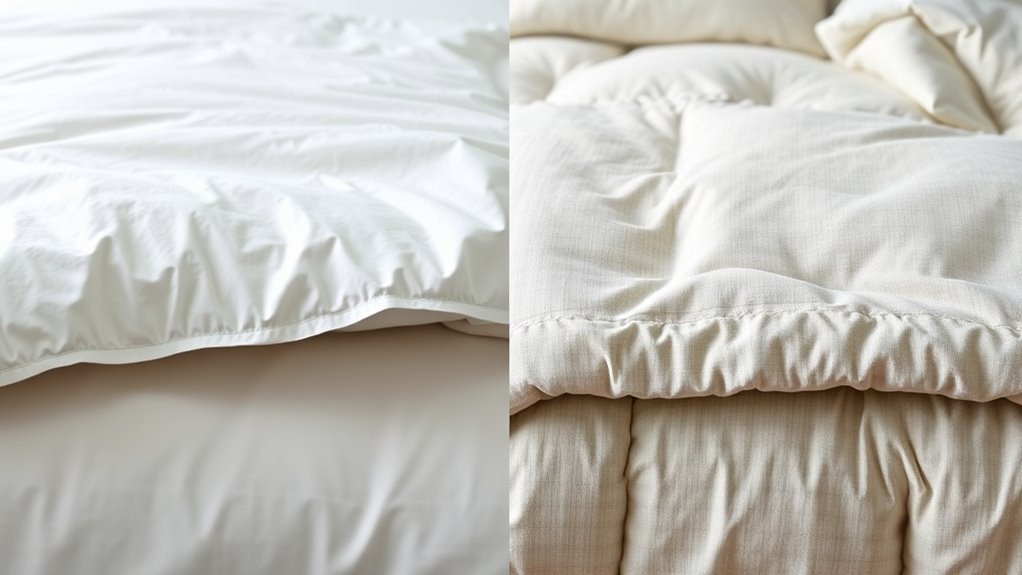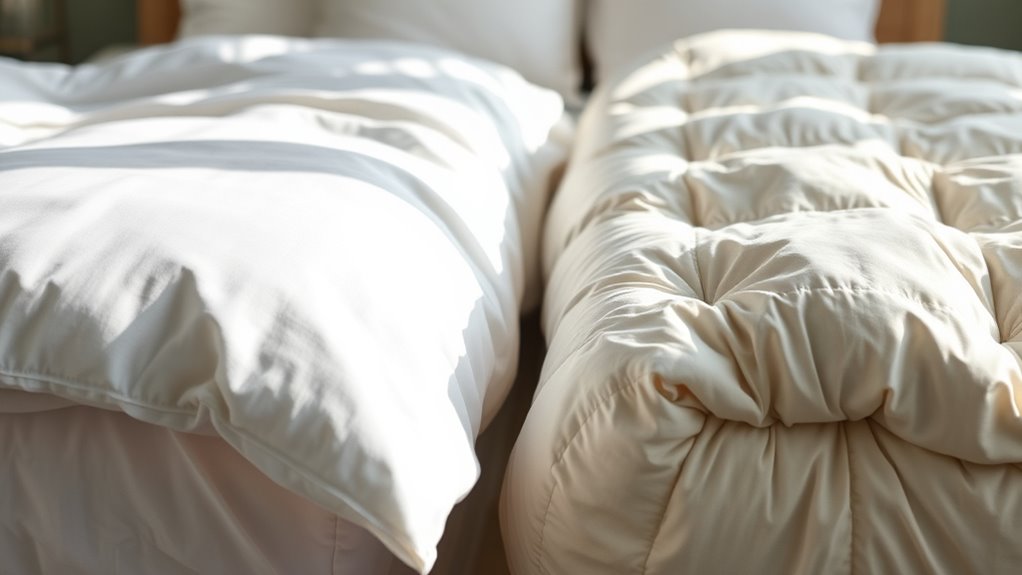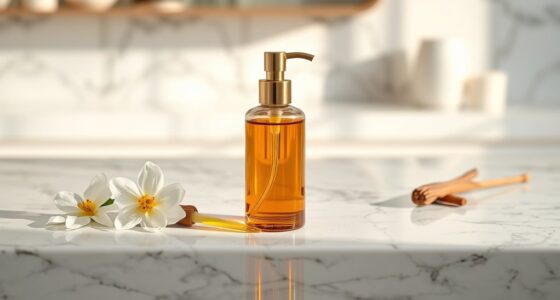A duvet is a soft, fluffy insert filled with wool, down, feathers, or synthetic fibers, usually covered with a removable duvet cover, allowing you to swap styles and adjust warmth easily. A comforter is a single quilted piece with sewn-in filling, offering a consistent look and warmth without needing covers. Duvets are better for seasonal updates, while comforters are simpler to maintain. If you want to understand these differences fully, keep exploring the details.
Key Takeaways
- Duvets are removable, fill-ins that can be swapped for seasonal comfort, while comforters are single, sewn-in quilts with fixed fillings.
- Duvets typically look fluffier and more voluminous, whereas comforters have a sleeker, flatter appearance.
- Duvets often contain high-quality natural or synthetic fillings for better insulation, suitable for colder weather.
- Comforters are usually machine washable and easier to care for, with less flexibility for seasonal adjustments.
- Duvets allow customization through covers and inserts, while comforters offer a consistent, all-in-one bedding solution.
What Is a Duvet?

Have you ever wondered what exactly a duvet is? It’s a soft, fluffy bedding item filled with natural feathers, wool, or synthetic fibers that keeps you warm. The duvet itself is like a shell, containing the fillings that provide comfort and insulation. It comes with a removable cover called a duvet cover, which protects the duvet and adds style. The cover is easy to remove and wash, making maintenance simple. Duvets are available in various sizes to fit different mattress dimensions, ensuring a cozy fit. Unlike a comforter, a duvet relies on the cover for decoration and protection. The fillings inside can be swapped out or changed for seasonal comfort, making the duvet versatile and practical for year-round use. Additionally, choosing the right filling material can affect warmth and breathability, tailoring the duvet to your specific preferences. Proper care and cleaning can extend the lifespan of your duvet and keep it feeling fresh. Understanding the different types of duvet fillings helps in selecting the best one for your needs.
What Is a Comforter?

A comforter is a ready-to-use, quilted blanket filled with synthetic fibers or down that provides warmth and comfort. It’s designed to be a complete bedding piece, eliminating the need for a separate cover. The comforter features a decorative stitched pattern that enhances its appearance, making it an attractive part of your bedroom decor. Its filling offers insulation, ensuring you stay warm without extra layers. Comforters are usually larger than your mattress, providing overhang for a neat, polished look and better coverage. Available in various colors, textures, and designs, they add style while serving a practical purpose. You simply lay it on your bed, and it’s ready to use, offering both comfort and visual appeal with minimal fuss. Additionally, filling material impacts the comforter’s warmth and durability, and choosing the right filling can also affect its maintenance requirements. A variety of fillings, such as down or synthetic fibers, can influence the comforter’s weight and care instructions. When selecting a comforter, consider the material quality to ensure longevity and comfort. Incorporating growth mindset principles can also encourage experimenting with different styles and materials to find what best suits your needs.
Key Differences in Appearance and Feel

You’ll notice that duvets tend to look plush, fluffy, and a bit rumpled, giving off a cozy vibe. Comforters, on the other hand, appear sleeker, more uniform, and often have a crisp finish. The way they fit on your bed also differs, with duvets fitting snugly inside covers and comforters hanging over the sides for a tidy look. Additionally, understanding home decor styles can help you choose the best bedding option to match your aesthetic. For instance, selecting the right type of bedding can influence the overall interior design theme of your bedroom. Incorporating textile materials that complement your decor can further enhance the visual harmony of your space. Recognizing the differences in bedding materials can also assist in selecting the most comfortable and durable option for your needs. Moreover, considering sleep comfort can help determine which bedding type will provide better rest and relaxation.
Visual Texture and Bulk
When comparing the visual textures of duvets and comforters, their appearance and feel reveal distinct differences. Duvets are plush and quilted, with a voluminous, puffy look thanks to their higher loft and down-filled insulation. They appear rumpled and substantial, giving a cozy, cloud-like texture. The visual bulk of a duvet makes it seem more substantial and plush, while a comforter’s thinner profile offers a streamlined look. Comforters, on the other hand, have a sleeker, smoother surface with less bulk, often looking flatter and evenly quilted. Their textural appearance is more uniform, providing a lighter, less bulky feel. Additionally, the choice between them can complement a rustic farmhouse bedroom by adding either a cozy, layered look or a more streamlined, minimal vibe. Understanding the visual texture can help you select the bedding that best matches your desired bedroom style and comfort. Incorporating textural contrast can further elevate the aesthetic and tactile experience of your bedding ensemble, especially considering the importance of appliance maintenance in creating a comfortable environment. Recognizing the material composition can also influence the durability and care requirements of your bedding.
Material and Warmth Level
The material and fill used in duvets and comforters directly influence their appearance and how they feel when you’re under them. Duvets often contain high-quality fillings like down or feathers, providing excellent insulation and a plush, pillow-like feel. Their fill weight can be adjusted to increase warmth, making them ideal for colder climates. Comforters typically use synthetic fabrics like polyester, offering a lighter, less insulating warmth suitable for moderate seasons. The material shell of a duvet, often cotton or silk, enhances breathability and temperature regulation, while comforters may use similar fabrics but focus less on insulation. Overall, the fillings and fill weight determine the warmth level and appearance, with duvets generally being thicker and more voluminous compared to the sleeker comforter.
Overhang and Fit
Duvets and comforters differ markedly in how they fit and how much they overhang the mattress, affecting both appearance and practicality. Duvets are usually sized to match the bedding dimensions, providing a snug mattress fit with minimal overhang. Comforters, however, are larger, creating more comforter overhang that drapes over the sides and foot of the bed, enhancing a cozy bedding style. This overhang impacts coverage, with comforters offering a more relaxed look and duvet covers emphasizing a tidy, tailored appearance. Your choice of duvet size or comforter overhang directly influences the overall aesthetic and functionality, whether you prefer a neat, fitted look or a plush, layered feel. Consider these factors to match your bedding style and desired coverage.
| Bedding Type | Fit | Overhang | Effect on Style |
|---|---|---|---|
| Duvet | Precise mattress fit | Minimal, few inches | Tidy, tailored |
| Comforter | Larger for drape | Generous, several inches | Relaxed, plush |
| Duvet | Snug, prevents shifting | Limited for clean look | Neat, streamlined |
| Comforter | Loose, may shift | Excess overhang, cozy look | Casual, layered |
| Both | Impacted by bedding dimensions | Affects coverage and appearance | Style and functionality |
Construction and Materials

When choosing between a duvet and a comforter, it’s important to contemplate their construction and materials. Duvets typically have thicker, natural or synthetic fillings and are paired with removable covers, while comforters are quilted with synthetic fibers in a single piece. The outer fabrics for both are usually soft and breathable, but their internal make-up affects warmth and durability.
Filling and Insulation
Choosing the right filling for your bedding directly impacts its warmth and comfort. Duvets often feature natural insulators like down, feathers, or wool, which provide excellent loft and insulation, trapping heat effectively. Synthetic fibers, such as polyester, are also common, offering lightweight warmth and easy maintenance. Comforters typically contain synthetic fiberfill, like polyester, sewn into quilting to ensure even distribution and prevent clumping over time. The construction of a duvet allows you to customize insulation by swapping out the insert, adjusting fill type, weight, and loft for different seasons. Comforters, however, rely on a fixed fill material, maintaining consistent insulation without the need for adjustments. Both options focus on providing warmth, but their construction and fill choices considerably influence their insulation properties.
Cover and Shell Fabric
The fabric covering your bedding plays an essential role in both comfort and durability. The shell fabric, or fabric shell, determines how breathable, resilient, and soft your duvet or comforter feels. Natural fibers like cotton and linen are popular for their breathability and ventilation, making them ideal for warmer climates. Microfiber and polyester are synthetic options that often feature in comforters, offering durability and easy maintenance. Comforters typically have a quilted construction, with the filling sewn directly into the fabric shell to prevent shifting. Duvet shells are usually made from lightweight, breathable fabrics, allowing for easy layering and style changes. Choosing the right shell fabric depends on your preference for breathability, feel, and maintenance.
How They Are Used and Maintained

Duvets and comforters are used and maintained differently to keep them in good condition. With a duvet, you need a removable cover, known as a duvet cover, which allows for easy maintenance—simply wash it frequently to keep it fresh. The duvet itself usually isn’t machine washable and requires regular fluffing and adjustment inside the cover to prevent clumping. For comforters, you can often wash the entire piece in a machine, but their bulk can make cleaning more challenging, sometimes needing professional care. Spot cleaning and following specific care instructions for different materials help prolong their lifespan. While comforters need less daily attention, both types benefit from proper maintenance to stay cozy and in top shape.
Size and Fit Considerations

Since size and fit considerably influence the overall look and comfort, it’s important to select a duvet or comforter that complements your mattress. Your choice should consider the dimensions and fit to guarantee proper coverage and proportions. Duvets are typically designed to match standard mattress sizes, fitting snugly without much overhang. Comforters, on the other hand, are often larger than the mattress, offering more overhang for a plush appearance. Many people opt for a size one step larger than their mattress—such as a Queen for a Full bed—to achieve the desired overhang and balanced look. For thicker mattresses or pillow-top beds, a larger size ensures adequate coverage and a proportionate, aesthetically pleasing fit. Always check the specific dimensions before purchasing.
Advantages and Disadvantages of Each

When choosing between a duvet and a comforter, consider how easy they are to maintain and how much flexibility they offer. Duvets often require more effort to clean because of the cover and insert, but they let you update your style easily. Comforters are simpler to care for and tend to stay in place better during sleep, though they don’t offer the same customization options.
Ease of Maintenance
Maintaining a duvet can be more time-consuming because you need to wash both the cover and the insert separately, following specific care instructions to prevent damage. The duvet cover is easy to remove and wash regularly, making it easy to keep clean. However, the duvet insert itself may require careful laundering or professional cleaning, especially if it’s delicate or natural down. Handling the bulkiness of a duvet insert can make washing more challenging, and some inserts aren’t fully machine washable. In contrast, comforters are generally easier to clean since they are a single piece and often machine washable, reducing laundering steps. The main disadvantage is that larger comforters can be bulky, making them harder to wash at home, especially if the fill material isn’t very washable.
Customization Flexibility
Duvets offer greater flexibility in customization because you can easily swap out duvet covers to match your decor or seasonal themes. With interchangeable covers, you can quickly refresh your bedding options without purchasing a new comforter. This allows for simple style updates, enabling you to reflect your personal preference or adapt to changing seasons. Duvet systems let you mix and match various covers with the same insert, providing a wide range of aesthetic choices for bedding sets. In contrast, comforters are limited since they’re one-piece items with fixed designs, making style updates more costly and less versatile. Overall, duvets give you the freedom to customize your bedding effortlessly, while comforters restrict your options to decorative pillows or bedsheets.
Which Is Better for Different Seasons?

Are duvets or comforters better suited for different seasons? Duvets with seasonal, lightweight fillings are perfect for summer, providing insulation without overheating. In winter, a thicker, insulated duvet offers maximum warmth, especially with a cozy duvet cover. Comforters, often available in all-season or lightweight styles, adapt well by layering with blankets or quilts, giving you flexible temperature control. Visualize:
- A lightweight duvet with a crisp duvet cover for summer coolness
- A heavy, down-filled duvet providing cozy warmth in winter
- A layered comforter setup with added blankets for versatile seasonal comfort
Choosing depends on insulation and warmth needs. Duvets excel with customizable warmth via different covers, while comforters offer layered flexibility, making either suitable for varying seasonal temperatures.
Factors to Think About When Choosing

When choosing between a duvet and a comforter, it’s important to contemplate your personal preferences and practical needs. Consider whether you value versatility and style options, as duvet covers allow you to easily change looks and match your decor. If you prefer simplicity and minimal maintenance, comforters typically require less fuss but may need professional cleaning. Think about insulation needs—duvets often provide better warmth, ideal for colder climates. Budget considerations also matter; high-quality duvets and covers might cost more upfront but can last longer. Reflect on your aesthetic preferences, since comforters offer a streamlined appearance, while duvets give you the flexibility to customize your style. Ease of cleaning is another factor—duvet covers are generally easier to wash and replace.
Making the Right Choice for Your Bedroom

Choosing the right bedding for your bedroom depends on your lifestyle, climate, and personal preferences. To make the best choice, consider these factors:
Selecting bedding tailored to your lifestyle, climate, and personal taste ensures a cozy and stylish bedroom retreat.
- The versatility of duvet covers enables quick seasonal updates and style flexibility—imagine swapping out covers to match your mood or decor.
- Comforter sets offer a streamlined look with less fuss, ideal for easy maintenance and convenience.
- Bedding materials influence sleep temperature; heavier duvets are perfect for colder nights, while lighter comforters suit warmer seasons.
Think about how often you want to wash your bedding and your budget. If you prefer easy to clean and adaptable decor, duvet covers and seasonal updates are ideal. For simplicity and affordability, comforter sets may be the better fit.
Frequently Asked Questions
Is It Better to Get a Duvet or Comforter?
When choosing between a duvet and a comforter, think about your priorities. If you want versatility and style updates, a duvet with removable covers is ideal. If you prefer convenience and quick setup, a comforter works best. Consider your climate too—duvets are better for colder weather, while comforters suit warmer seasons. Ultimately, pick what fits your lifestyle, maintenance preferences, and comfort needs best.
What Are the Disadvantages of a Duvet?
The disadvantages of a duvet include its challenging cleaning process, often needing professional help, and the cumbersome task of inserting and removing the cover. You might find that the filling clumps over time, causing uneven warmth and requiring fluffing or replacement. Duvets can be costly upfront and in maintenance. Plus, poorly fitted covers tend to slip or bunch, leading to discomfort and frequent adjustments, which can be frustrating for daily use.
Why Do Americans Call Duvets Comforters?
You might wonder why Americans call duvets comforters. It’s mainly because, in the U.S., the term “comforter” has become a catch-all for plush, quilted bedding that’s easy to use. Since comforters are ready to go without a cover, people prefer the simpler name. Marketing and industry practices also helped popularize this terminology, leading to regional differences and some confusion with what other countries call duvets.
Can Any Comforter Go in a Duvet?
You might think any comforter can go in a duvet, but not all are suitable. To guarantee a perfect fit, check the comforter’s dimensions and construction type. Comforters labeled “duvet compatible” or with a box stitch are best. Avoid thick or bulky comforters, as they can be hard to insert and strain the cover. Choosing the right comforter guarantees easy fitting and a cozy, stylish bed.
Conclusion
Choosing between a duvet and a comforter is like selecting the right key for your unique melody. Each offers its own harmony of comfort and style, fitting different seasons and moods. Think about your preferences, maintenance, and bedroom vibe. When you pick the one that resonates with you, it transforms your sleep into a peaceful symphony. Ultimately, your choice crafts the melody of restful nights, making your bedroom truly your sanctuary.









